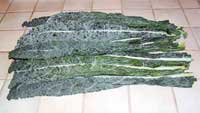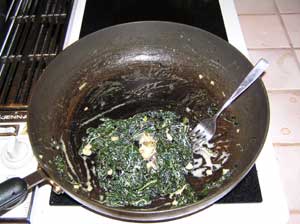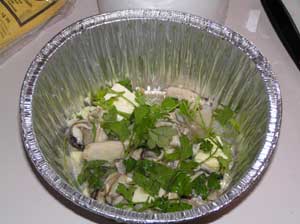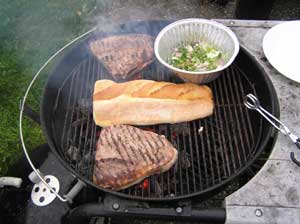How many oysters?
How about 63.9 ounces? That's what it says on the tub. (We didn't weigh them ourselves. That's for websites like How Much Is Inside?).
Sixty three point nine ounces seems to be the standard commercial tub size sold by seafood wholesalers around here. They probably call it the "subcompact tub", since the big guys must order oysters by the truckload. Why 63.9 ounces and not 64? Who knows? Maybe restaurateurs tend to order, "Oh, just a bit less than a half gallon".
So, why that many oysters?
Well, it's Thanksgiving, and we are having turkey, and there is nothing better with turkey than oyster stuffing. So, one of our friends who is joining us this Thanksgiving said he'd contribute the oysters, and he did.

The Lacinato Kale Test
 We would have
considered ourselves irresponsible if we had not performed the
appropriate quality assurance testing on these oysters prior to the big
event. So, our first test was the Lacinato Kale Test.
We would have
considered ourselves irresponsible if we had not performed the
appropriate quality assurance testing on these oysters prior to the big
event. So, our first test was the Lacinato Kale Test.Lacinato kale is a variety of kale often sold as dinosaur kale because of its wrinkled leaves. It is a local specialty here in Port Angeles and grown by farmers like Nash Huber. For the test, we took about a pound of lacinato kale and cleaned it, removing the central stalks, then we heated up a frying pan with about a tablespoon of olive oil. When the pot was nice and hot, we added the kale and sauteed it for a bit, until it became slightly crisp.
Then we added the oysters, about ten of them, and let them cook a bit. When the oysters had curled and the kale was tender, we added four of tablespoons of heavy cream, two cloves of chopped garlic, a half teaspoon of Pernod, a quarter teaspoon of freshly ground nutmeg, and some salt and freshly ground pepper. When the cream had reduced a bit, we tossed it all up and ate.
The results were spectacular. In fact, they were so good it was all we could do to get a photograph before eating the last scraps.
TEST RESULTS: The oysters passed the Lacinato Kale Test with flying colors.

The Grilled Oyster Test
The next test was more serious and required much higher temperatures and special handling of the oysters. The ingredients were simple. We took ten of the oysters, draining most of their liquor, and put them in an aluminum dish with two tablespoons of deadly milk concentrate (aka butter), a half cup of chopped parsley, four minced cloves of garlic, and some salt and pepper.When our manual pyranometer indicated that the grill was incredibly hot, that is when it was so hot we couldn't keep our hands over it for even a second, we put the oysters, in their dish, on the grill. To prevent burning, we shook them around a bit using special tongs designed for the purpose.
The oysters began to bubble, the butter melted, the parsley wilted, the smoke billowed.
Interestingly, the oysters did not burn. As they cooked, they yielded liquid, so the aluminum dish was soon full of a frothing mixture of oyster liquor and butter. We stirred a few times, and we shook the dish around so everything mixed nicely, and after about 20 minutes on the fiery grill the oysters were shrunken and lightly smoked.
TEST RESULTS: Once again the oysters passed with flying colors. They have been accepted by Kaleberg Labs for use in our turkey stuffing.
Stand by for our post-Thanksgiving report on the stuffing and further adventures of the Kaleberg Oysters.



